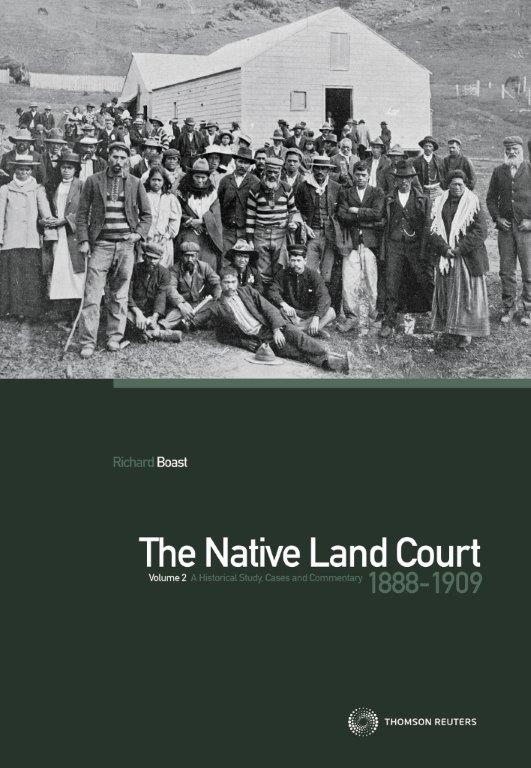Native Land Court Vol.2 images
In August The Native Land Court Volume 2 - A Historical Study, Cases and Commentary - 1888-1909 made its appearance.
As Professor Boast QC says in his Author’s Preface:
“This volume continues the story of the Court down to 1909, the date of the enactment of the Native Land Act of that year, which reformed and re-arranged the complex statute law relating to the Court and Maori land administration. The first part of the book is a survey of the history of the court and related bodies; the second is comprised of a sample of fully annotated cases, each with an introductory essay explaining the context of the decision.”
The book's images
Included on its cover, and in its text, are a collection of images, each compelling in their own right. They add to our understanding, bringing an immediacy that words often lack.
On the front cover - Ahipara Native Land Court 1904
[caption id="attachment_7382" align="aligncenter" width="530"]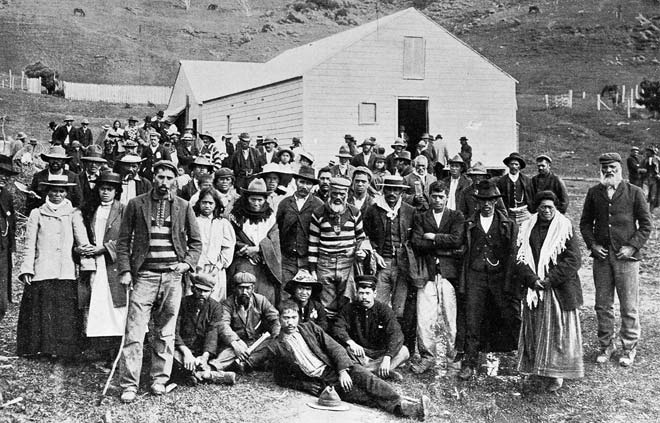 Photo credit: Auckland City Libraries - Tāmaki Pātaka Kōrero, Sir George Grey Special Collections Reference: AWNS-19041027-11-1 – Permission granted to use[/caption]
Photo credit: Auckland City Libraries - Tāmaki Pātaka Kōrero, Sir George Grey Special Collections Reference: AWNS-19041027-11-1 – Permission granted to use[/caption]
The photo is of far-North Māori attending a hearing of the Ahipara Native Land Court, (27 October 1904) held in the building in the background.
To claim rights to their tribal lands Māori had to attend the court in person. This often meant travelling long distances and finding accommodation for months on end. They were also expected pay fees associated with their claims; for solicitors, surveyors and court fees.
The Locked-Up Native and Crown Lands
The image on the back cover is compiled from a supplement to Auckland’s paper The New Zealand Herald for Friday Nov. 17th 1905 pictured below.
[caption id="attachment_7387" align="aligncenter" width="530"]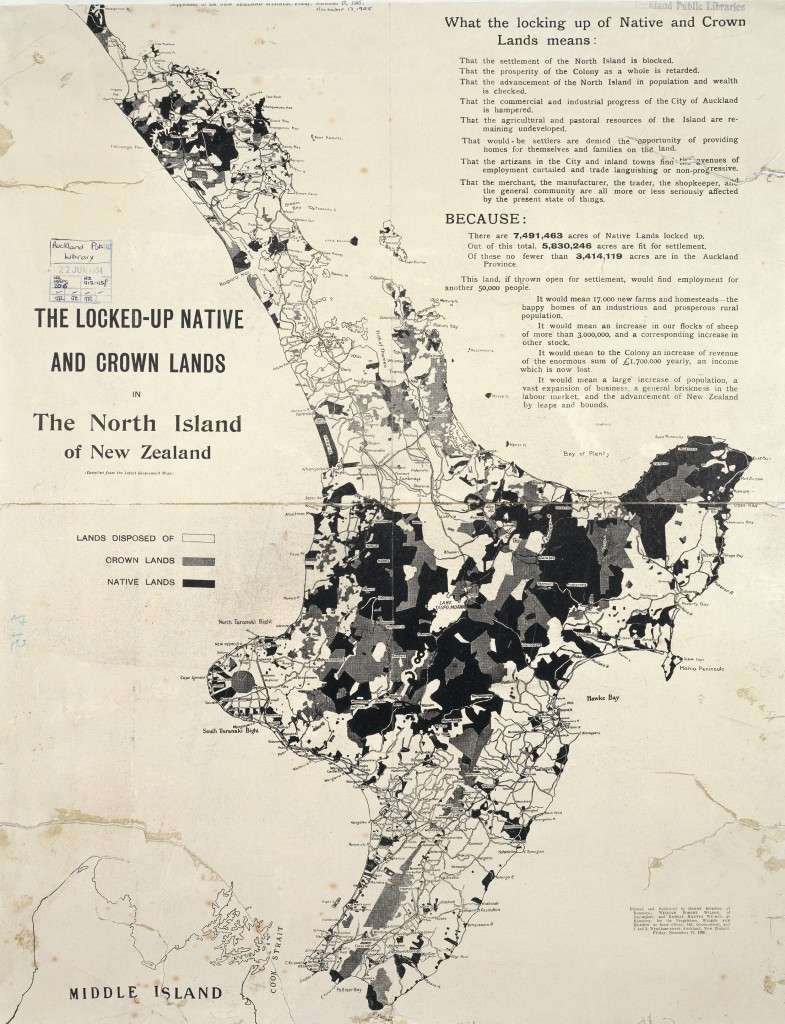 Image credit: Sir George Grey Special Collections, Auckland Libraries, NZ Map 206 – Used with permission[/caption]
Image credit: Sir George Grey Special Collections, Auckland Libraries, NZ Map 206 – Used with permission[/caption]
The map, its legend and text, are very clear in intent and meaning. Here is an excerpt:
"What the locking up of Native and Crown Lands means:
That the settlement of the North Island is blocked
That the prosperity of the Colony as a whole is retarded
That the advancement of the North Island in population and wealth is checked …”
To see more please visit: http://www.teara.govt.nz/en/interactive/19536/locked-up-native-and-crown-lands
Walter Lawry Buller
[caption id="attachment_7390" align="aligncenter" width="500"]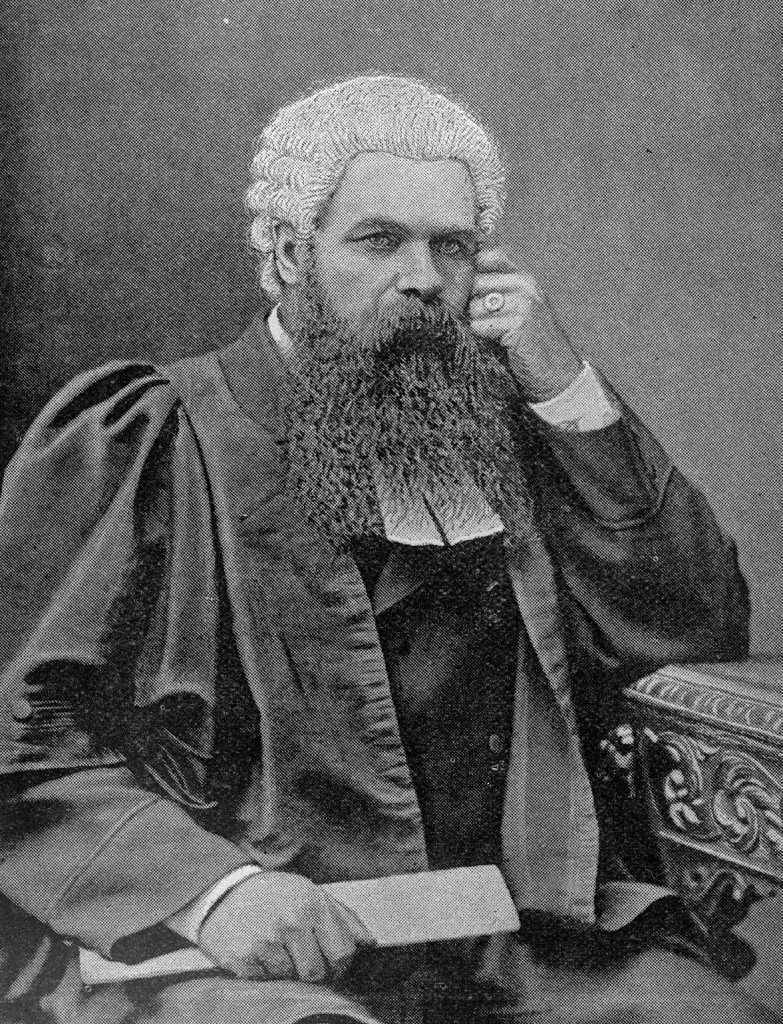 Photo credit: Alexander Turnbull Library, Wellington, NZ. Reference: 1/2-005260-F. Used with permission.[/caption]
Photo credit: Alexander Turnbull Library, Wellington, NZ. Reference: 1/2-005260-F. Used with permission.[/caption]
The Native Land Court text under this photo tells us that Buller was “…a barrister and natural historian. The date of the photograph is not known but was probably taken in the 1880s. Buller had a large Maori land practice and frequently appeared in the Native Land Court at Cambridge and other places.”
Despite the size of his legal practice he is more generally known these days for his ornithological studies. His book "A History of Birds in New Zealand" published in 1873, with a second edition in 1888, established him as an expert and the book's images by Dutch illustrator John Gerrard Keulemans are famous. The one below shows the now extinct huia.

The Maori, he thought, 'are dying out and nothing can save them. Our plain duty as good compassionate colonists, is to smooth down their dying pillow.'
This excerpt about him from TeAra – The Encyclopedia of NZ below gives us an insight on attitudes of the time.
“Buller held the prevailing view that the native plants, birds and people of New Zealand would inevitably be displaced by the more vigorous European immigrants. The Maori, he thought, 'are dying out and nothing can save them. Our plain duty as good compassionate colonists, is to smooth down their dying pillow.' Similarly, he generally rejected as hopeless T. H. Potts's ideas for the conservation of both native forests and birds. However, in 1891 he backed the governor, Lord Onslow, in his successful plea for statutory protection of birds such as the huia, and the creation of sanctuaries at Resolution and Little Barrier islands. But despite advocating these moves, Buller remained equivocal about their value and continued to take specimens of the rarer birds for his own and other collections.”
For more please see: http://www.TeAra.govt.nz/en/biographies/1b46/buller-walter-lawry
Airini Donnelly
[caption id="attachment_7394" align="aligncenter" width="500"]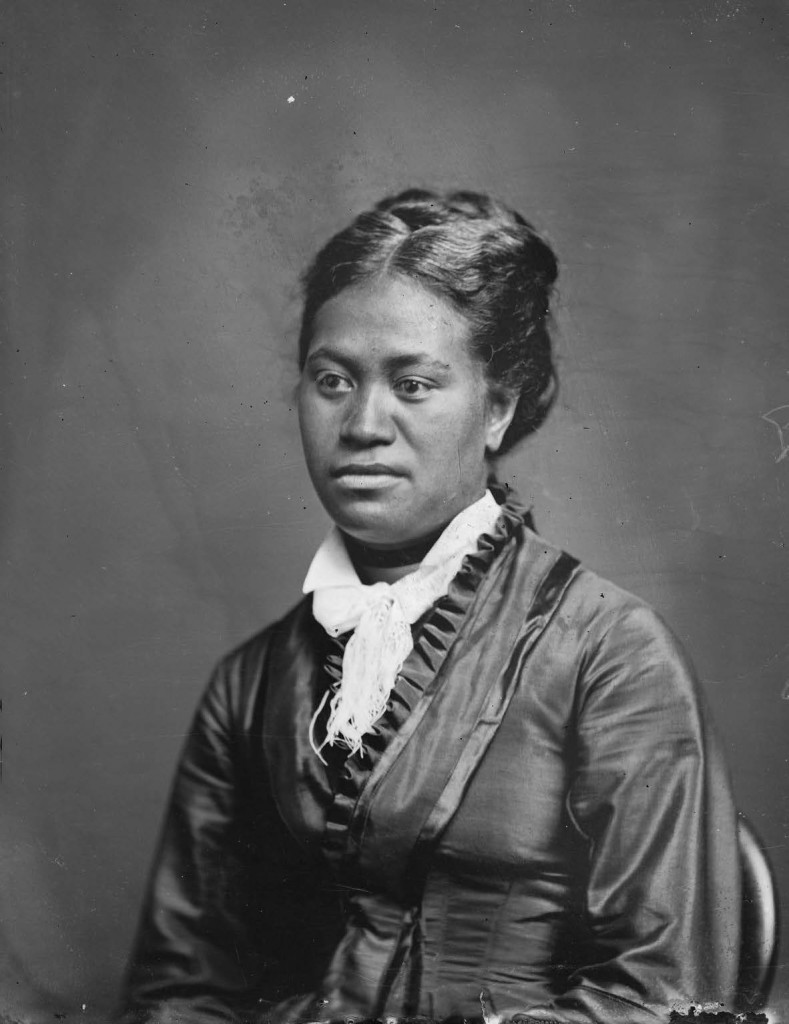 Photo credit: Alexander Turnball Library, Wellington,NZ. Reference: 1/4-022134-G. Photographer: Samuel Carnell. Used with permission.[/caption]
Photo credit: Alexander Turnball Library, Wellington,NZ. Reference: 1/4-022134-G. Photographer: Samuel Carnell. Used with permission.[/caption]
Professor Boast writes about this image: “Airini Donnelly, grandniece of the Hawke’s Bay rangatira Renata Kawepo and Tareha. Airini, married to George Prior Donnelly, was a leading member of the Hawke’s Bay gentry class, was prominent in Maori politics, and was involved in many cases in the Native Land Court (for example the Omahu and Owhaoko cases), and in numerous cases in the ordinary courts including those relating to the Kaiwaka block and Renata Kawepo’s will, both of which ended in the Privy Council. The photograph was taken some time between 1870 and 1880.”
...early promise shown as a litigant was developed in her later years
A search for more information about Airini found numerous references including this below from Te Ara - The Encyclopedia of New Zealand:
“In her late teens Airini rose to prominence as an advocate for her people before the Native Land Court in Rangitikei, where she pleaded a claim to land in the Otamakapua block. Kawepo was ill and unable to appear before the court, and Airini persuaded her uncle to allow her to represent him and other claimants, although it was not customary to allow a woman to appear in such a role. She argued her case successfully and was awarded 1,000 acres in her own right. This early promise shown as a litigant was developed in her later years.”
For more please visit: http://www.teara.govt.nz/en/biographies/2d14/donnelly-airini
When Airini challenged her Uncle's will public interest was intense and covered extensively in newspapers. Here’s a sample from The Star, (Christchurch) Issue 6315, 13 August 1888, Page 2 retrieved from Papers Past.
Renata Kawepo's Strange Will Case
The great Renata will case was settled, as far as Sir James Prendergast could settle it, for the matter had to be taken to the Court of Appeal, last week.
A stranger, more interesting, or more perplexing case is rarely outside the pages of a novelist. The heroine, Airini , Anglice Alice Donnelly, may almost rank, in fact, with Mr Rider Haggard’s latest heroine, whose fair shoulders bore Mr Meeson’s last will and testament tattooed upon them. If not quite so attractive in person as Augusta Smithers, or so indelibly “branded”, Airini Donelly is certainly from this time to be likely to be equally famous in New Zealand. She is the grand-niece of Renata Kawepo, the wealthy Maori chief of Omahu, near Napier, and having displeased him in her choice of a European husband in 1878, uncle and niece quarreled. The lady naturally resented the slight put upon the man of her choice.
To read the rest of the piece please visit: Papers Past. (Despite her efforts Airini lost the case.)
Renata Kawepo
[caption id="attachment_7400" align="aligncenter" width="500"]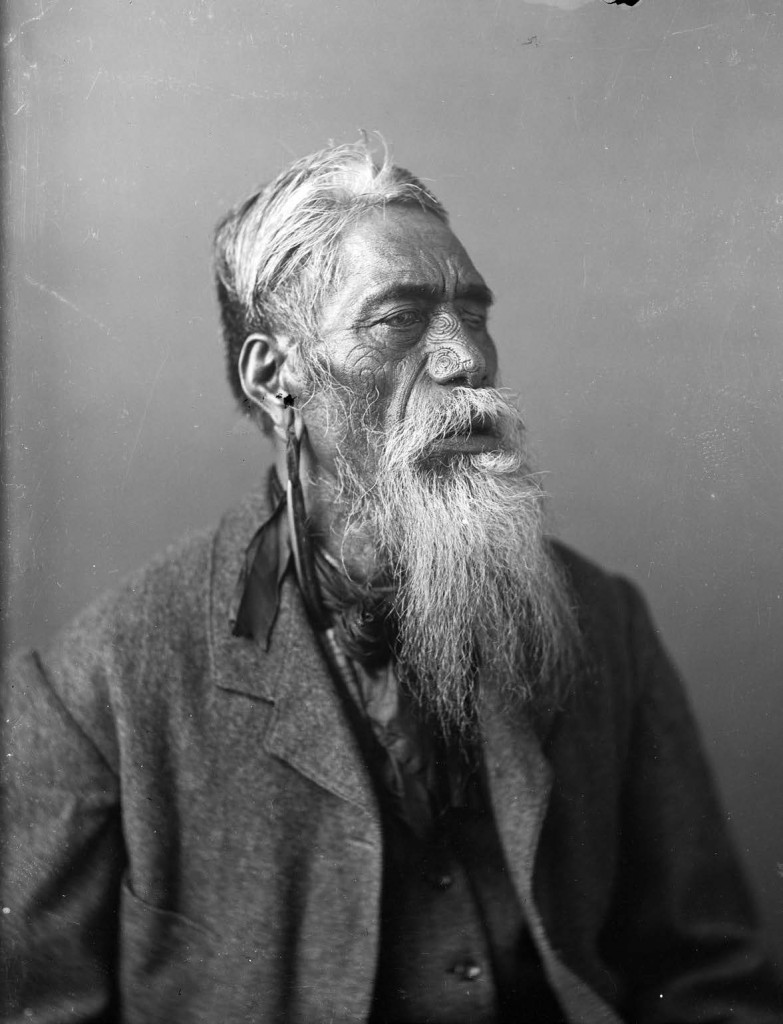 Photo credit: Alexander Turnball Library, Wellington, NZ. Reference: 1/4-022121-G. Photographer: Samuel Carnell c 1880s. Used with permission.[/caption]
Photo credit: Alexander Turnball Library, Wellington, NZ. Reference: 1/4-022121-G. Photographer: Samuel Carnell c 1880s. Used with permission.[/caption]
Had he been born in Europe under favorable social conditions he would have become a Bismarck, a Garibaldi, or a Napoleon
That quote comes from an account of his death published in Hawke's Bay Herald, Volume XXIII, Issue 8028, 16 April 1888, Page 3. Here's a little more from the same piece. It clearly shows the respect he commanded.
At a quarter past S o'clock on Saturday morning, at Omahu, there passed away to the shadow land the greatest of the Maori chieftains whose names are bound up in the history of this district. Renata Kawepo was all that is conveyed in the expressive word " Rangatira," and this is as true of him with regard to the old days, prior to European settlement, as it is of him since with a rare sagacity he saw that it was for the good of his people that they and the pakeha should live together in amity. The calibre of Renata's mind was great. To his people he was in the old days emphatically a "cunninge" man in the Carlylean sense — he was of the metal of which rulers are made. Had he been born in Europe under favorable social conditions he would have become a Bismarck, a Garibaldi, or a Napoleon: but Fate decided that his genesis should be in southern latitudes, and he fulfilled his destiny by being Renata Kawepo; missionary and warrior.
Professor Boast says about this photo of him:
"Renata Kawepo, one of the leading chiefs of Hawke’s Bay, who was involved in many Land Court cases, including the cases relating to the Owhaoko blocks in the Taihape region. He died a very wealthy man in 1888, with an estate worth over £100,000. Over 6,000 people, Maori and Pakeha, attended his tangi. Litigation over his estate resulted in the Privy Council decision in Donnelly v Broughton in 1891. The photograph was taken in the 1880s.”
